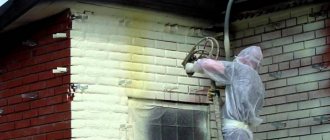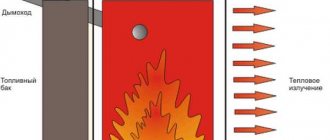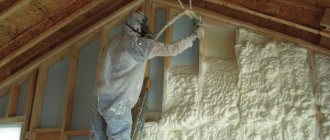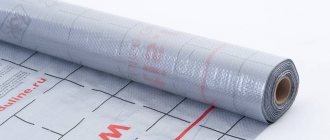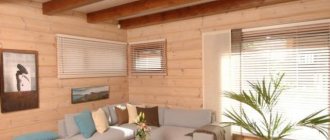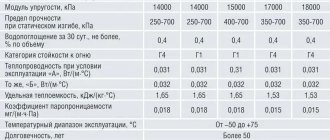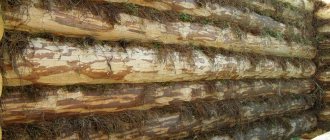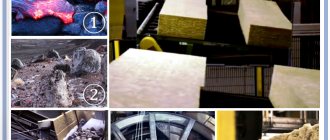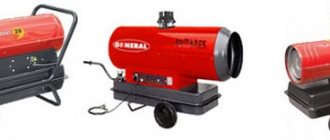In modern construction, thermal insulation materials play a particularly important role. About 50% of the total demand is for mineral wool, which is represented by several types. These are glass wool , slag wool, and basalt insulation . The latter, in its structure and production technology, is not much different from its mineral analogues, but has higher mechanical characteristics. This has made basalt thermal insulation the most common among all types of mineral wool.
What is basalt insulation
The differences between glass, slag and basalt insulation lie primarily in the raw materials used in production. “Mineral wool” is the general name for this group of thermal insulation materials. Basalt thermal insulation is made from molten gabbro-basalt rock. For this reason, it is also called stone wool.
How to produce
The entire process of producing basalt insulation in stages:
- Gabbro-basalt is crushed and then melted at a temperature of more than 1500 °C.
- The rock is then sent to special drums to obtain, after stretching, very fine fibers up to 7 microns thick and up to 50 mm long.
- The fibers are glued together using arbolo-urea resins. They do not contain formaldehyde, therefore they are safe for health. Fibers can be located inside the insulation in different directions: vertically, horizontally, structurally corrugated or chaotically.
- After gluing, the raw material is heated to 300 °C and then passed through a press twice. This is necessary to obtain a layer with a certain rigidity and strength.
- Then the slabs themselves are formed. Shrink film is used to package products.
How to form individual slabs of basalt wool
Release forms and sizes
The dimensions of basalt insulation depend on the form of its release. The material is produced in the following forms:
- Rolls. The most common sizes are: 50x1000x4000, 200x1000x3000, 200x1000x6000, 200x1000x4750, 200x1200x2000 mm.
- Plates with a width of 600 mm, a length of 1000 or 1200 mm, a thickness of 20, 50, 100 mm. These are standard commonly found sizes.
- Mats or cylinders - their dimensions vary depending on the manufacturer.
There is another type of such thermal insulation - basalt chips. This is a waste product from the production of stone wool, which is formed when cutting slabs or rolls. The crumbs are packed into bags and then sold as bulk material. According to reviews, basalt chips as insulation are 3-4 times cheaper, but it has one drawback - only horizontal surfaces can be insulated.
Using crumbs as thermal insulation
The specific thickness of the thermal insulation layer for the roof, walls or ceiling is selected based on thermal engineering calculations. To do this, you can use the following regulatory documents.
- SNiP 02/23/2003 “Thermal protection of buildings”.
- SP 23-1-1-2004 “Design of thermal protection of buildings.”
- SNiP 23-01-99* “Construction climatology”.
Satisfied
I am rebuilding a private house and adding additional rooms. The house is located in an open area, the wind constantly blows through it, so in winter it is always cool inside. It became clear that there was no way to solve this problem without insulating the walls. Friends advised me to use glass wool, but I wanted to buy something newer and better for my home.
I found the website of the First House company, several types of modern insulation are presented there. The store salesperson recommended using Technofas Cottage basalt insulation for my purposes. It has such advantages as: fire resistance, service life up to 50 years, heat and sound insulation, waterproof, conducts steam and is resistant to rodents and insects.
For me, these factors became decisive and I began to insulate the house with the help of Technofas Cottage products. The house became warmer and quieter thanks to sound insulation. Overall I was pleased.
Key characteristics of basalt insulation
One of the most important characteristics of stone wool is its high thermal insulation ability. It is provided by the voids that form between the fibers. Due to such distances, the material acquires good sound insulating ability. The sound wave is simply reflected from many fibers and quickly attenuates at any frequency. Among the main characteristics of basalt thermal insulation it is worth highlighting:
- Thermal conductivity – λ = 0.032-0.048 W/mK. Comparable to the thermal insulation ability of cork, regular and extruded polystyrene foam, and foam rubber.
- Water absorption by volume – up to 2%.
- Vapor permeability – 0.3 mg/m·h·Pa.
- Compression ability – up to 30%.
- Density – 25-200 kg/m3.
- Ultimate compressive strength at 10% deformation – 5-80 kPa.
- Temperature range – from -60 to +1114 °C.
Differences between basalt insulation and glass wool
Glass wool is based on cullet (80%) - a sought-after secondary raw material that is generated during the production of glass products or sheet glass. The composition also includes dolomite, sand and limestone. The raw materials are also heated to 1500 °C, after which they are inflated with steam inside a centrifuge and treated with a polymer aerosol. Next, the material is polymerized, cooled, and cut into slabs or rolls.
The difference between basalt thermal insulation and glass wool is not limited to production technology. The table shows the differences in materials more clearly:
| Parameter | Glass wool | Basalt-based wool |
| Thermal conductivity coefficient (λ), W/m K | 0,039 | 0,032-0,048 |
| Density | Low (creates less load on structures) | High |
| Fibers | Soft and long. The length of the fibers is 2 times longer, and the thickness is 2 times less than that of stone wool. Glass wool is more elastic and less friable. It is more convenient to use on structures of irregular geometry. | Fragile and short, they make the material not very elastic. |
| Shrinkage rate | It shrinks quite strongly during use. | Low |
| Flammability | Depending on the modulation, it can withstand temperatures up to 400-700 °C, after which it begins to melt and lose its performance properties. | Refers to non-combustible materials (NG). |
| Chemical resistance | Susceptible to chemicals. | Not affected by chemicals. |
| Soundproofing | Higher than its basalt counterpart. | Lower than glass wool. |
| Moisture absorption | Up to 15% | Up to 2% |
| Price | Cheaper than stone wool | More expensive than glass wool |
| Scope of application | For temporary buildings and country houses, it is more profitable to buy glass wool. | Stone thermal insulation is more suitable for residential premises: apartments and houses. The absence of glass particles makes stone wool safer, also for renovations. |
Production technology
To obtain basalt fabric for a specific purpose, the rock undergoes complex technological processes consisting of 4 stages:
- Preparation of raw materials (volcanic crushed stone): grinding, washing and drying.
- Melting the crumbs in a special oven to obtain thread.
- Formation of complex fibers in a continuous manner.
- Weaving fabric or creating other shapes.
The diameter of the igneous rock filament ranges from 8 to 20 microns, and the length is up to 50 km. In factory conditions, a vertical renewal method is used to maintain the molten raw material in a uniform consistency for the production of continuous long fiber.
Basalt threads are further processed using weaving methods: plain, satin or twill. The dark color is due to the presence of iron oxide in the magmatic alloy.
What are the advantages of stone wool
The main advantage of stone wool is its non-flammability. According to GOST 30244-94 “Construction materials. Combustibility testing methods" it is classified as non-combustible materials, which are marked with the letters "NG". This means that according to test results, stone wool:
- loses no more than 50% of the sample mass;
- causes an increase in temperature in the furnace of no more than 50 °C;
- maintains a stable flame combustion for no more than 10 s.
An example of stone wool insulation of a rafter structure
Basalt insulation can withstand temperatures up to +1114 °C without reaching the melting point. Thanks to this, the material can be used to insulate devices operating at high temperatures. Other advantages of stone wool include:
- Ability to pass steam. It is this property that makes stone wool better than expanded polystyrene, which “does not breathe.” Moisture contained in the air easily passes through the thermal insulation layer. The insulation does not get wet, is not subject to condensation and does not change its insulating properties. This allows the material to be used in baths, saunas, and residential premises.
- High strength. The density of basalt insulation prevents its deformation during long-term use. The material will serve for a long time without changing shape or size. It will easily absorb loads and resist slipping.
- Chemical passivity. Stone wool can be laid next to metal structures without any fear - rust will not appear on them. The material is also not susceptible to acids and alkalis.
- Biological resistance. Stone wool is not susceptible to microorganisms and fungi. It is also resistant to rodents, which are too tough for such material.
- Naturalness. The thermal insulation is based on a completely natural material – gabbro-basalt. Unlike glass wool insulation , when using stone wool a person does not experience irritation of the skin and respiratory tract.
- Hydrophobicity. The material is able to repel water - once it gets on the surface of the insulation, it cannot penetrate inside.
- Light weight. Thanks to this, the insulation boards are very easy to install without the help of outsiders.
Please note: biological and chemical resistance, combined with high strength and low water absorption, provide stone wool with a long service life - up to 40-50 years, and this is one of the most important indicators of thermal insulation quality.
Advantages and disadvantages
Stone wool does not absorb moisture, unlike mineral wool.
The advantages of basalt insulation are manifested in almost everything, with the exception of price. Therefore, the question of whether basalt insulation is harmful can be answered with confidence - no. Even despite the fact that such dangerous components as phenol and formaldehyde are used for production. Hearing this, some may jump to conclusions that are not supported by facts. These two substances are bound in the structure of the material and cannot leave it in any way; this is absolutely impossible. If price is important, then there is the option of insulating the house with the most economical material - sawdust.
What is good about stone wool in terms of ecology:
- it is made of stone, that is, a natural material;
- this is not dusty insulation;
- withstands heating up to 1100 degrees without releasing harmful substances;
- complete chemical inertness;
- does not cause irritation to the epidermis upon direct contact.
From all sides the material is extremely positive, therefore it is useless to look for shortcomings in basalt insulation. Of course, if you wish, you can pull them by the ears, but this is no longer constructive.
Does stone wool have any disadvantages?
Resins are used in the production of stone wool. Even if they are harmless, they still pollute the atmosphere and reduce the environmental friendliness of the material. But this drawback can be ignored, since the insulation is usually placed inside structures, under layers of hydro- and vapor barrier. Taking this into account, the negative impact of the material on the environment is practically zero. There are a few other minor drawbacks:
- Vapor transmission. This is not exclusively a disadvantage of stone wool, but it limits its use for insulating basements and ground floors. In such cases, it is worth using extruded polystyrene foam.
- The presence of many seams. The form of basalt thermal insulation is slabs and rolls. Because of them, you have to lay a lot of beams and make seams. But in reality, if installed correctly, this is not a problem.
- Harmfulness. It's a bit exaggerated. If during the work you use PPE (personal protective equipment), at least goggles, gloves, a respirator and closed clothing, then no problems with installation will arise.
If you are just choosing insulation, we advise you to study another type of thermal insulation: “Everything about XPS extruded polystyrene foam: composition, characteristics, pros and cons, review of manufacturers.”
Advantages and disadvantages
The advantages of basalt fiber include the main properties:
- high resistance to fire, fire safety;
- wide range of temperatures at which volcanic rock sheets can be used;
- increased tensile strength;
- low breathability;
- slight accumulation of static electricity;
- durability - service life is 50 years;
- vibration resistance;
- environmental friendliness. The composition includes only continuous basalt fiber;
- good adhesion to various materials;
- resistance to acids and alkalis;
- low cost and huge raw material base;
- affordable price. A square meter of basalt fabric costs an order of magnitude lower than thermal transfers made of polyester.
Among the disadvantages, one is noted - the complexity of production associated with the special technology for producing a continuous thread.
Scope of application of stone wool
The main purpose of stone wool is thermal insulation of floors, walls and building structures. The material is especially widespread in frame construction, but it can be used in any other areas. Due to its non-flammability, stone wool is recommended for thermal insulation of objects that are subject to increased fire safety requirements.
Insulation with basalt insulation is relevant in many areas. What objects and structures can be insulated with this material:
- rooms with high humidity: baths, saunas, etc.;
- buildings with walls in the form of sandwich panels or layered masonry;
- ship structures and cabins on ships;
- chimneys and pipelines operating in different temperature conditions – from -60 to +1114 °C;
- ventilation pipes;
- internal and external walls, interfloor partitions;
- flat roofs and rafter structures;
- interfloor ceilings and attic coverings;
- “wet” and ventilated facades;
- heating and heating equipment.
Stone wool is the recommended insulation material for various types of finishing, including siding. You can learn more about its installation: “Vinyl siding: installation and methods for calculating the material required for the work.”
What can you use basalt insulation for?
Types of basalt insulation
During manufacturing, the material is given different densities. to say which basalt insulation is better, since each has its own characteristics that determine the scope of application. Depending on the density, the material can be used for thermal insulation of different structures:
- 25-30 kg/m3. Suitable for insulating floors, since they are located horizontally and bear virtually no load.
- 35 kg/m3. Optimal density for thermal insulation of a sloping roof.
- 40-50 kg/m3. At this density, stone wool can withstand the load from the next slab placed on top. Relevant for wall insulation, including in frame structures.
- 50-60 kg/m3. Recommended for layered masonry.
- 70-80 kg/m3. Boards with this density behave well in a ventilated façade system.
- 120-140 kg/m3. Recommended for use for facades made using the “wet method”, i.e., to be plastered.
- 150-200 kg/m3. The highest density slabs are used to insulate flat roofs.
An example of using stone wool in the walls of a frame house
According to the degree of rigidity and thickness of the fibers
In the marking of stone wool you can find 2 designations:
- BTV, which means making insulation from a thin thread;
- BSTV - indicates the use of ultra-fine threads in the production.
According to another classification, basalt thermal insulation is divided into types depending on rigidity:
- Soft cotton wool. It consists of the finest fibers and has a porous structure. Mainly designed to retain air to create a thermal insulation layer, in which it is very effective due to its porosity. Due to its light weight, soft wool should not be subject to significant loads.
- Medium hard or semi hard. Relevant for arranging ventilated facades and creating protection for ventilation ducts.
- Hard cotton wool. Designed for thermal insulation followed by reinforcement and application of plaster. Used for floor screed installation.
How to insulate a floor with stone wool
Foil insulation as a separate type of basal wool
Separately, it is worth mentioning about foil-coated basalt insulation . It retains heat indoors even more reliably and provides so-called double thermal insulation. All thanks to the layer of foil, which can be on either one or both sides of the insulation. Cotton wool with a one-sided foil coating should be positioned so that the foil faces the inside of the room, so that heat is reflected into the room and not out.
What foil basalt insulation looks like
Mineral wool
To insulate walls and ceilings, mineral wool is optionally used in the form of rolls and slabs; there is also a granule option, their size is more than 1 centimeter in diameter. Bulk mineral wool in granules is a vapor-permeable and fire-resistant material, it is resistant to high temperatures. When working with the material, you need to protect exposed skin and respiratory organs. It is quite difficult to find any obvious weak points of the material; the only drawback is the fear of water and the loss of its thermal insulation qualities when wet.
Popular manufacturers of basalt insulation
Both domestic and foreign companies are engaged in the production of basalt insulation. Among the brands of this material that everyone knows, there are several. For convenience, they are presented in the table:
| Manufacturer | What the products look like | Product Features |
| "TechnoNIKOL" | The manufacturer offers several series of stone wool. The main ones:
| |
| Isover | It mainly produces thermal insulation for private construction. The series features Isover:
| |
| Rockwool | Produces complex systems for thermal insulation of various structures. Rockwool insulation is presented in several series: “Roof Butts”, “Caviti Butts”, “Facade Butts”. | |
| Isoroc | For roof insulation, the manufacturer offers Izoruf-NL stone wool. To solve various problems of thermal insulation, the line includes insulation materials “Ultralight” (density 33 kg/m3), “Izolight” (50–33 kg/m3), “Izolight-lux” (60–33 kg/m3), “Isovent”, “Izoruf” ", "Isoflor". | |
| Knauf | There are 2 types of thermal insulation in the line:
|

